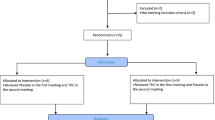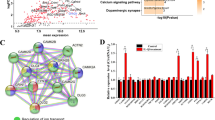Abstract
Currently hypoglossal nerve–genioglossus axis is the major research core of OSA pathogenesis. The pathogenesis of OSA incidence changes before and after menopause needs to be clarified further. Little is known about the influences of ovariectomy on hypoglossal motoneurons. In the research, we utilized a rat ovariectomy model to evaluate the expression changes of 5-HT2A and α1-Adrenergic receptors in the hypoglossal nucleus and to explore the involvement of BDNF/TrkB signaling and endoplasmic reticulum molecular chaperones in the hypoglossal nucleus. Results indicated that the expression of 5-HT2A and α1-Adrenergic receptors reduced dramatically in the hypoglossal nucleus of ovariectomized rats. The apoptosis level of hypoglossal motor neurons increased markedly in the OVX groups. The up-regulated expression of BDNF and down-regulated expression of TrkB were found in the OVX groups. Ovarian insufficiency resulted in the activation of UPR and the loss of CANX-CALR cycle. Estrogen replacement could restore these changes partially. Estrogen level influences the expression of neurotransmitter receptors, and regulates BDNF/TrkB signaling compensation and endoplasmic reticulum homeostasis, which might be one of the pathogenesis of menopausal female OSA. The results reveal a new perspective for studying female OSA from the view of hypoglossal nerve and hormonal changes and attempt to propel 17β-estradiol toward a feasible therapy for female OSA.




Similar content being viewed by others
References
Dursunoglu N, Dursunoglu D. Do we neglect women with sleep apnea? Maturitas. 2007;56(3):332–4.
Peppard PE, Young T, Barnet JH, et al. Increased prevalence of sleep-disordered breathing in adults. Am J Epidemiol. 2013;177(9):1006–14.
Franklin KA, Sahlin C, Stenlund H, et al. Sleep apnoea is a common occurrence in females. Eur Respir J. 2013;41(3):610–5.
Heinzer R, Vat S, Marques-Vidal P, et al. Prevalence of sleep-disordered breathing in the general population: the HypnoLaus study. Lancet Respir Med. 2015;3(4):310–8.
Won C, Guilleminault C. Gender differences in sleep disordered breathing: implications for therapy. Expert Rev Respir Med. 2015;9(2):221–31.
Fabbrini M, AricA I, Tramonti F, et al. Sleep disorders in menopause: results from an Italian multicentric study. Arch Ital Biol. 2015;153(2–3):204–13.
Netzer NC, Eliasson AH, Strohl KP. Women with sleep apnea have lower levels of sex hormones. Sleep Breath. 2003;7(1):25–9.
Wesstrom J, Ulfberg J, Nilsson S. Sleep apnea and hormone replacement therapy: a pilot study and a literature review. Acta Obstet Gynecol Scand. 2005;84(1):54–7.
Cori JM, O’Donoghue FJ, Jordan AS. Sleeping tongue: current perspectives of genioglossus control in healthy individuals and patients with obstructive sleep apnea. Nat Sci Sleep. 2018;10:169–79.
BuSha BF, Strobel RJ, England SJ. The length-force relationship of the human genioglossus in patients with obstructive sleep apnea. Respir Physiol Neurobiol. 2002;130(2):161–8.
Brandes IF, Zuperku EJ, Dean C, et al. Retrograde labeling reveals extensive distribution of genioglossal motoneurons possessing 5-HT2A receptors throughout the hypoglossal nucleus of adult dogs. Brain Res. 2007;1132(1):110–9.
Jin XT, Cui N, Zhong W, et al. Pre- and postsynaptic modulations of hypoglossal motoneurons by alpha-adrenoceptor activation in wild-type and Mecp2(-/Y) mice. Am J Physiol Cell Physiol. 2013;305(10):C1080–90.
Sánchez MG, Estrada-Camarena E, Bélanger N, et al. Estradiol modulation of cortical, striatal and raphe nucleus 5-HT1A and 5-HT2A receptors of female hemiparkinsonian monkeys after long-term ovariectomy. Neuropharmacology. 2011;60(4):642–52.
Park YM, Kanaley JA, Padilla J, et al. Effects of intrinsic aerobic capacity and ovariectomy on voluntary wheel running and nucleus accumbens dopamine receptor gene expression. Physiol Behav. 2016;164(Pt A):383–9.
ThyagaRajan S, Hima L, Pratap UP, et al. Estrogen-induced neuroimmunomodulation as facilitator of and barrier to reproductive aging in brain and lymphoid organs. J Chem Neuroanat. 2019;95:6–12.
Scharfman HE, MacLusky NJ. Estrogen and brain-derived neurotrophic factor (BDNF) in hippocampus: complexity of steroid hormone-growth factor interactions in the adult CNS. Front Neuroendocrinol. 2006;27(4):415–35.
De Paul AL, Pons P, Aoki A, et al. Heterogeneity of pituitary lactotrophs: immunocytochemical identification of functional subtypes. Acta Histochem. 1997;99(3):277–89.
El-Khatib YA, Sayed RH, Sallam NA, et al. 17β-Estradiol augments the neuroprotective effect of agomelatine in depressive–and anxiety-like behaviors in ovariectomized rats. Psychopharmacology. 2020;237(9):2873–86.
Sun BC, Liu L, Yang L, et al. Effect of estrogen on genioglossus and hypoglossal nucleus of female rats. Shanghai Kou Qiang Yi Xue. 2017;26(2):146–50.
Wang W, Cui G, Jin B, et al. Estradiol Valerate and Remifemin ameliorate ovariectomy-induced decrease in a serotonin dorsal raphe-preoptic hypothalamus pathway in rats. Ann Anat. 2016;208:31–9.
Wang W, Bai W, Cui G, et al. Effects of estradiol valerate and remifemin on norepinephrine signaling in the brain of ovariectomized rats. Neuroendocrinology. 2015;101(2):120–32.
Zhang J, Bai W, Wang W, et al. Mechanisms underlying alterations in norepinephrine levels in the locus coeruleus of ovariectomized rats: Modulation by estradiol valerate and black cohosh. Neuroscience. 2017;354:110–21.
Bassani TB, Bartolomeo CS, Oliveira RB, et al. Progestogen-mediated neuroprotection in central nervous system disorders. Neuroendocrinology. 2023;113(1):14–35.
Wang W, Salvaterra PM, Loera S, et al. Brain-derived neurotrophic factor spares choline acetyltransferase mRNA following axotomy of motor neurons in vivo. J Neurosci Res. 1997;47(2):134–43.
Rind HB, Butowt R, von Bartheld CS. Synaptic targeting of retrogradely transported trophic factors in motoneurons: comparison of glial cell line-derived neurotrophic factor, brain-derived neurotrophic factor, and cardiotrophin-1 with tetanus toxin. J Neurosci. 2005;25(3):539–49.
Schaser AJ, Stang K, Connor NP, et al. The effect of age and tongue exercise on BDNF and TrkB in the hypoglossal nucleus of rats. Behav Brain Res. 2012;226(1):235–41.
Chan CB, Ye K. Sex differences in brain-derived neurotrophic factor signaling and functions. J Neurosci Res. 2017;95(1–2):328–35.
Wu L, Dang Y, Liang LX, et al. Perfluorooctane sulfonates induces neurobehavioral changes and increases dopamine neurotransmitter levels in zebrafish larvae. Chemosphere. 2022;297: 134234.
Scotton E, Colombo R, Reis JC, et al. BDNF prevents central oxidative damage in a chronic unpredictable mild stress model: The possible role of PRDX-1 in anhedonic behavior. Behav Brain Res. 2020;378: 112245.
Wilkerson JE, Mitchell GS. Daily intermittent hypoxia augments spinal BDNF levels, ERK phosphorylation and respiratory long-term facilitation. Exp Neurol. 2009;217(1):116–23.
Remondelli P, Renna M. The endoplasmic reticulum unfolded protein response in neurodegenerative disorders and its potential therapeutic significance. Front Mol Neurosci. 2017;10:187.
Jóźwiak-Bębenista M, Sokołowska P, Siatkowska M, et al. The importance of endoplasmic reticulum stress as a novel antidepressant drug target and its potential impact on CNS disorders. Pharmaceutics. 2022. https://doi.org/10.3390/pharmaceutics14040846.
Uvarov AV, Mesaeli N. Enhanced ubiquitin-proteasome activity in calreticulin deficient cells: a compensatory mechanism for cell survival. Biochim Biophys Acta. 2008;1783(6):1237–47.
Coe H, Bedard K, Groenendyk J, et al. Endoplasmic reticulum stress in the absence of calnexin. Cell Stress Chaperones. 2008;13(4):497–507.
Nakamura K, Bossy-Wetzel E, Burns K, et al. Changes in endoplasmic reticulum luminal environment affect cell sensitivity to apoptosis. J Cell Biol. 2000;150(4):731–40.
Acknowledgements
Zilong Liu and Shanqun Li conceived and designed the experiments. Huan Lu performed the experiments. Huan Lu and Qinhan Wu analyzed the data. Huan Lu and Qinhan Wu have contributed to manuscript preparation. Huan Lu and Qinhan Wu contributed equally to this work and shared the first authorship.
Funding
This work was supported by grants from The National Key Research and Development Program of China (No. 2018YFC1313600) and the National Natural Science Foundation of China (No. 81900086, 81570081, 81770083).
Author information
Authors and Affiliations
Corresponding authors
Ethics declarations
Conflict of interest
The authors declare that they have no conflicts of interest.
Ethical approval
All experimental procedures conformed to the guidelines of National Institutes of Health Guide regarding the care and use of animals and were approved by the Medical Experimental Animal Administrative Committee of Shanghai Medical College of Fudan University. All effects were made to minimize animal suffering.
Additional information
Publisher's Note
Springer Nature remains neutral with regard to jurisdictional claims in published maps and institutional affiliations.
Supplementary Information
Below is the link to the electronic supplementary material.
Rights and permissions
Springer Nature or its licensor (e.g. a society or other partner) holds exclusive rights to this article under a publishing agreement with the author(s) or other rightsholder(s); author self-archiving of the accepted manuscript version of this article is solely governed by the terms of such publishing agreement and applicable law.
About this article
Cite this article
Lu, H., Wu, Q., Liu, Z. et al. Impact of ovariectomy on neurotransmitter receptors BDNF/TrkB and endoplasmic reticulum molecular chaperones in rat hypoglossal nucleus. Sleep Biol. Rhythms (2024). https://doi.org/10.1007/s41105-024-00520-5
Received:
Accepted:
Published:
DOI: https://doi.org/10.1007/s41105-024-00520-5




